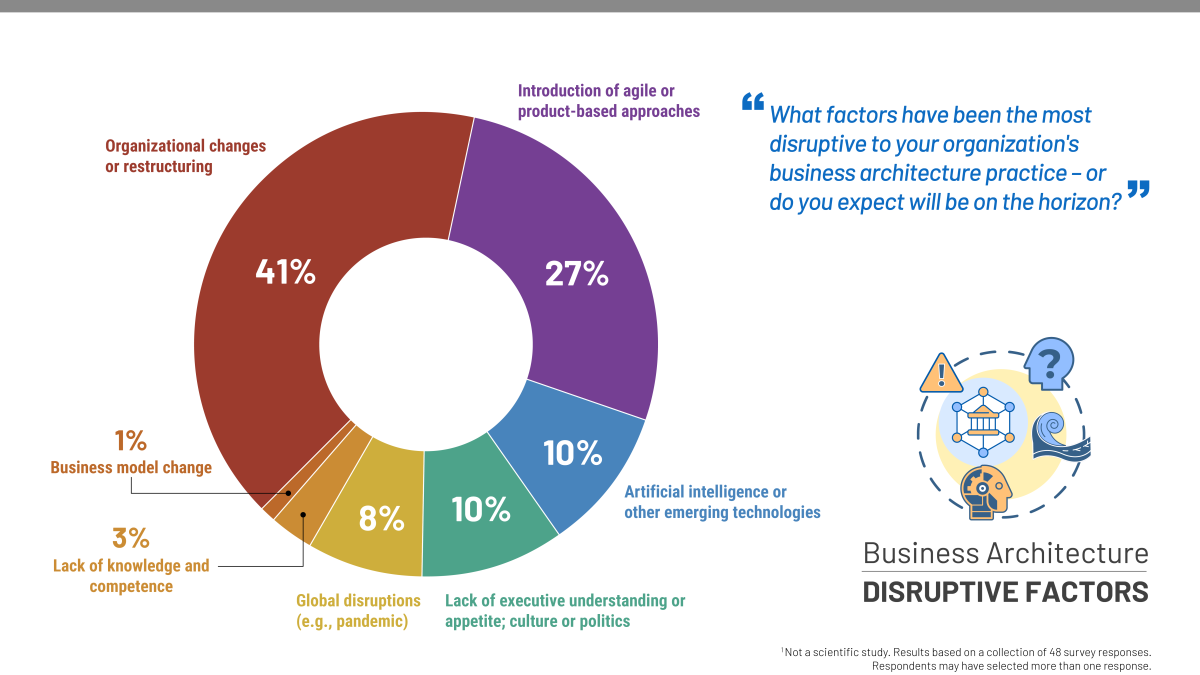Respondents answered the survey question: What factors have been the most disruptive to your organization's business architecture practice – or do you expect will be on the horizon?
A set of selected thoughtful comments from respondents are below:
- “Uncertainty around our function’s position in the organization could lead to a dilution to our value add even though there is an acknowledgement of the benefits of business architecture.”
- “Having to explain and educate new leaders and team members.”
- “Business leaders need consistent alignment of skills to strategy, this alignment is still very functional based choices rather than strategy focused choices. Business architecture helps plan competency needs and positioning for competitive advantage, but the practice needs more work to position effectively.”
- “As a new discipline in the organization, changes in org structure are quite disruptive. We are not yet established as part of the fabric and we are currently going through an org change. It will either be positive or negative disruption. TBD.”
- “We've had many retirements over the years within our organization. Most disruptive have been retirements within our executive leadership team as well as our CEO. As a result, business architecture socialization efforts has been a bit of a churn.”
- “Uncertainty in the financial markets (which is linked to company revenue) has led to belt tightening around budgets and hence a step back from business architecture initiatives internally.”
- “The organization has gone through a major portfolio transformation and has realigned which is causing a positive shift. This is a new opportunity for me so I'm getting my bearings. [We] also have a very mature practice but have not embarked on any value stream conversations but realize this is a gap.”
- “Most executives rise to the c-suite due to financial acumen, very little understanding of architectural aspects of their business.”
- “There are ongoing questions as to whether the product owner role replaces the need for a business architect.”
- “I did not select AI because to me that is a solution not a business outcome. If you already talk in terms of journeys, experience, and value, like we do, then AI in itself does not disrupt business architecture application. It's just one solution each time to achieve a business outcome. The others are disruptive to how business architects interact in an organization.”
- “Poor implementation (the change was not recognized as cultural/behavioral) of what was supposed to be a truly end-to-end approach to change, resulting in unclear lines of accountability and an architecture team that was no longer embedded in the change process but marooned in the CFO function.”
- “Business architecture focuses on transformation through compiled information. This information is derived by capturing relationships across all other architecture domains and the business intent they impact. Because the data we need to determine this information and thus provide transparency is spread across an organization, we are dependent on the political posturing of those who own the data. When reorgs and/or organizational leadership changes, business architects must reassess and re-educate as required to ensure business architecture remains a central and effective part of strategic decision making. This could mean influencing new leadership, introducing existing and creating new educational curriculums, reestablishing relationships to keep data access, accepting business architecture organizational changes, or even the abandonment of business architecture as a recognized practice altogether.”
- “In my opinion, there several major factors disrupting or potentially disruptive to our practice. Obviously, organizational changes of all sorts expose our vulnerability and the outcome is too often a testimonial of our past ability to create value (be seen as relevant)...The second factor [encompasses] all the changes that feed top management’s magical thinking or [offers] seductive answers to their fears and pains, let’s call it the mermaids calls factor: agilism, AI in a box, platform vendors promises. We could also [consider] the context driven factors that may jeopardize our efforts, with shorterm-ism being one big hurdle that can disrupt our capacity to act.”
- “For example, silos or lack of clarity on R&R due to product approaches/organizational changes. On culture - vicious circles of staying busy and ignoring problems “start something, fire fight it” avoiding learning from past miscues, misogyny…”
- “Lack of guidance and direction from the top/group level. A federated organization with no common business view or ownership of customer, offering or processes.”
- “Organizational changes happen so often in our organization that you are always running behind to keep up to date with the baseline and advise properly. Also because some changes do not even get the chance to prove their worth.”
- “We tend to be excited about the new technologies and anxious to apply without considering and architecting the underlining readiness to optimize the impacts. AI / ML rely heavily on business architectures and the consistent data / process's structure, without these key "basics", implementation strategies will bring desirable results in reality.”
- “In my experience, org changes have delayed or derailed opportunities for business architecture to flourish. Each leadership change has restarted, reinvented, or in some way revised the role. When agile product ownership was introduced, the Scrum Master hired to establish the scrum teams had no knowledge or understanding about business architecture, They developed teams and processes that didn’t include business architecture. We were not able to reverse the trend as more product owners were established Ignorance and no desire to learn. When we had a leader that supported the team, they didn’t invest or enforce policies established through governance that upheld and furthered the practice.”
